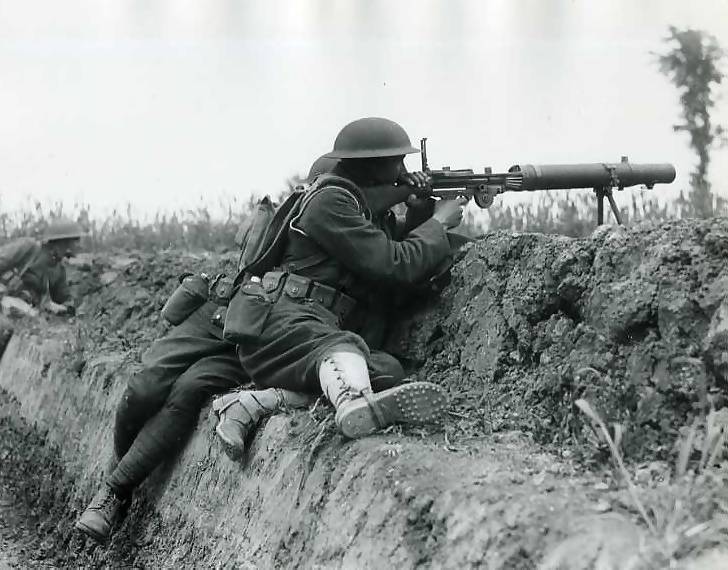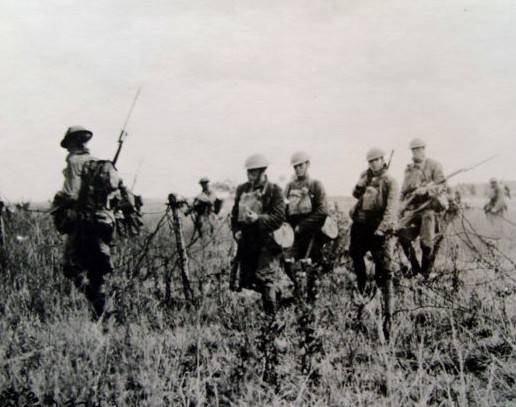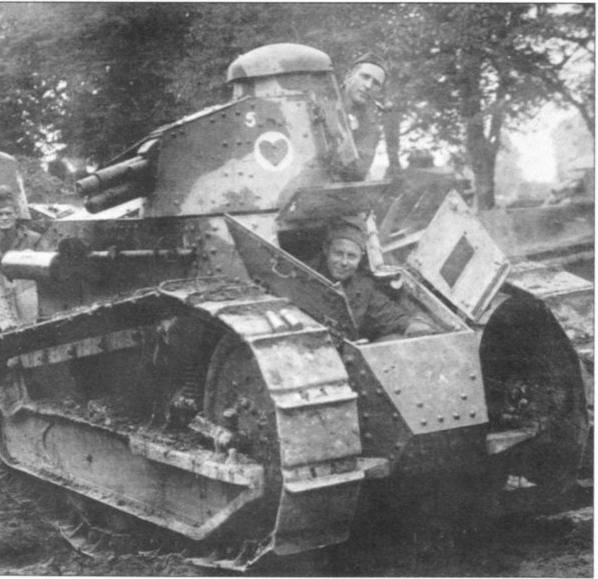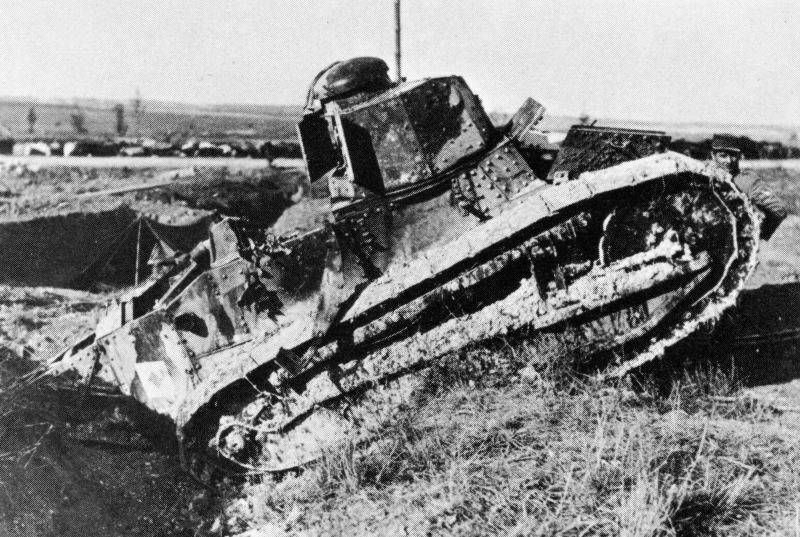Baptism of the Armored Forces of the USA. Tanks in the Saint-Miel operation. 2 part
In the rain, bogged down in viscous, wet soil, they barely covered the distance to the German positions.
The 34-I and 35-I groups of heavy tanks due to bad communications and technical problems are late and only single vehicles reach the German trenches. The 505 Tank Regiment, overtaking the heavy tanks stuck on the approaches to the trenches and in the trenches, pursued the retreating units of the German infantry and entered the area of Vievil and Thiocur.
14-I and 17-I tank groups, with the support of their artillery fire, blinding the enemy with smoke shells, and with the support of infantry attack the German resistance units and machine gun nests. They help the infantry master the der. Esay. Tanks Schneider could not lead the advance of the infantry, but they followed closely its first wave until Mezere. Here, an 50-mm projectile hit and killed and injured 15 into one of the tanks. Two Schneider were blown up by land mines.
It was the turn and the American tankers.
The 345 th battalion under heavy concentrated German artillery fire struggled to overcome numerous enemy trenches, and, losing two tanks from direct shells hit, Schneider attacked Hey along with tanks. Finding not destroyed the bridge over the river. Rupp de Mud, he quickly crossed over to the opposite bank.
5 advanced tanks along with the infantry entered the Esey.
In this place, tankers captured a dozen prisoners. The battalion commander received permission to cross the bridge if he was not mined. His report read: “We sneaked through the bridge over the cat, waiting for the opportunity to take off every second air, but it turned out that the bridge was not mined. Then we transferred the three remaining tanks over the bridge and set off along the road to Pan. When we reached Pann, the infantry following behind us declared that the place was occupied by the enemy and that it did not want to enter there. To calm her down, we drove into a place on the tank, where the tank crew, after engaging in hand-to-hand combat, captured 30 prisoners.
Thus, the tankers not only helped their infantry to seize the village, but also captured trophies. Tanks continued pursuing the enemy on Ben, but were forced to return - the infantry fell behind.

7. American machine gunners in battle.
Afternoon attack continued. The tanks attacked the groves to the north and northeast of Bene, destroying a number of machine-gun points and capturing a light battery.
The artillery that supported the combat vehicles during this offensive rendered them considerable assistance by firing smoke bombs at the edges of groves and at the enemy observation posts on the ridges east and west of Mäser, where Schneider tanks operated. These ridges were especially effectively shrouded in a smoke screen.
The tanks of the 344 th battalion in the 8 watch with great difficulty reach the German positions, tearing wire barriers and trying to overcome the trenches. At this point, some of the cars get stuck in the trenches, and the other in search of aisle bypasses the German trenches from the west. In 8 hours 15 minutes, the commander of the 344-th battalion sent with his post pigeon his first combat report: “20 tanks in the battle for the first line of German trenches. Trenches in terrible condition for tanks ... We are doing everything possible to pull out the stuck tanks and move them forward. ”

8. American infantrymen.
The battalion 1's platoon attacked the Arlem wedge - and he managed to destroy the wire barriers that prevented the advancement of the infantry. But these tanks could not overcome the enemy's first line trenches. The remaining battalion vehicles advanced between Rishkur and the west bank of the river in the direction of La Evil.
Then the tanks attacked the machine-gun nests of the enemy, located in the grove Rath. Although many tanks were stuck in the trenches, 25 vehicles reached the town of Nonsar, bursting into it before its infantry. Tank fire suppressed German machine guns on the bell tower, and then 77-mm guns on the eastern edge of the Rath and Kar groves were destroyed.
Due to the mud, the large number and considerable width of the enemy trenches, the tanks consumed gasoline three times faster than expected, and by the 15 watches were left without fuel. Some gasoline was delivered on a sled.
The battalion commander recalled: “The trenches turned out to be difficult to reach, and the battalion commander saw some officers and privates coming out of the tanks in order to get the latter out of a dangerous position. Here he saw three company commanders who stood on the parapet under fire and pointed their way through heavy areas. ”

9. The tank of the 344 th tank battalion of the 304 th brigade.
As a result, by the end of the day, the tank units reached: 34, 35, and 505, the regiment of the Vieville-Thiocur region, 17, and 14, Esey, 345, Battalion, and 344 battalion - Nonsar.
Despite the difficult tactical conditions, the tanks directly supported their infantry, advancing on the flanks of the I and IV corps on 10 - 13 km, and in the center - on 23 - 25 km.
In the 304 Tank Brigade of the 174 tanks that took part in the battle on that day, 22 was stuck in trenches and crossings, 14 failed for technical reasons and 3 were destroyed by enemy artillery fire.
On September 13, due to the lack of fuel, most of the tank units were able to take part in the battle only after 12 hours. In 14 hours 40 minutes, the supply manager of the 304 Brigade sent a message from Beaumont that "the supply was stuck in Beaumont until the engineers repaired the roads."
The tanks supporting the 4th Corps helped the infantry attack the forest de Rupe and capture the places. Gamm
In the I case, tanks did not take part in the pursuit of a randomly departing enemy. By nightfall, they concentrated in Saint-Benoit and Vignell, tearing off the infantry that had gone ahead. The 7 reserve battalion 344 tanks drained fuel from other vehicles — and it was they who, in the early hours of September 13, were able to support units of the 1 division in the direction of Vignille. On the way, the platoon had to tinker with the fan belts of the fans, but he did not meet the resistance of the enemy. Fuel for the rest of the battalion 344 tanks was delivered only in 14 hours. After receiving the fuel, the remaining 50 tanks of the 344-th battalion marched through Nonsar to Vignel, where they arrived at midnight.
The 30 Tank Battalion 345 and French Tank 22 advanced to Saint-Benoit.
On September 14, tank units had combat contact with the enemy only at the front of the 4th corps. The 344 Tank Battalion, having lost contact with the headquarters of the 1 Division, on its own initiative acted through Saint-Maurice - in the direction of Voel.
At 9 in the morning hours, when the tanks were located in 2 km west of Voila, information was received that the enemy had just been driven out of this town, which was occupied by 20's French soldiers. An officer's watch was sent to the grove south of the town - he should have tried to establish contact with any part of the 4th corps.
At that moment, three trucks delivering fuel to the battalion were attacked by a German aircraft. The latter struck a bomb strike and opened machine-gun fire, but to no avail.
The battalion stopped between Avilier and Voiel, and the tanks were hidden in the hedges. At this time, 2 German aircraft passed over them on a low level flight. The attention of the Germans was distracted by the American plane that attacked them - and he was shot down west of Voel.
A tank patrol consisting of three vehicles and 5 infantrymen on armor was advanced.
At about 13 hours, the tank patrol stumbled upon the German infantry battalion that was following in a closed marching column from Jonville to Voel. The patrol immediately turned into battle formation and opened fire on the enemy. The battalion, having suffered heavy losses, began to retreat to Jonville. The tanks, pursuing the Germans, on the approach to Jonville, were met with fire from the enemy's light battery and also began to retreat. Under the fire of 77-mm guns in one vehicle the engine failed, and the patrol commander turned to his battalion for support. While waiting for help, another tank died out - then both of the failed tanks were attached to the only combat-ready tank and safely removed from the battlefield.
After a tank platoon of 5 vehicles arrived, Jonville was attacked, with the destruction of 5 machine guns and a battery of Germans. Moreover, the Americans tried to take the captured guns, but under shrapnel fire (several people were wounded) the guns were left, and the platoon joined the battalion.
The 344 th battalion concentrated in Jonville, but, having lost contact with its infantry, the Germans did not wait for the counter-attack - at 21 an hour he received an order from the brigade commander to withdraw to the brigade gathering area - to Thiocur forest. The battalion arrived in Thiocur only by the 5 clock on September 15, being hit by enemy artillery.
The 345 th battalion and the French tanks also received orders to retreat into this grove, where on September 15 the brigade stood on rest. 16 September the 304 Brigade was concentrated in the grove of Azel, where it remained until September 19 - being repaired and preparing for the movement to Argonne.
The participation of tanks in the elimination of the Saint-Mielsky ledge ended.
As a result of a successful operation, the front length was reduced by 24 km. The Germans lost only prisoners and officers to 15000, as well as 443 guns. Americans lost killed and wounded 7000 people.
And a significant role in the successful outcome of the operation was played by the tank breakthrough, despite the serious roughness in the course of its implementation, which caused the high rates of movement of the advancing troops. The pace of movement of the tank units of September 12 was quite high - despite the difficult terrain conditions (soil and water obstacles), lack of agility and training of units and subunits of the 304 tank brigade.
The relatively insignificant losses of the French and American tanks from enemy fire (the 2 tank was blown up by land mines and 5 were destroyed by a direct hit of projectiles) are partly due to the fact that most of the German artillery retreated to the position of Michel, and the enemy did not offer any stubborn resistance.

10. Burnt Renault FT.
The German command, in order to halt the unimpeded offensive of tanks, attempted to meet armored vehicles with artillery battery fire located in populated areas or in the forest, used land mines, machine-gun fire, and bombing from airplanes (tank collection points and vehicle columns with fuel were also fired upon).
Attention is drawn to the insufficiently close connection between the tankers and the combined-arms command. So, the 344 th battalion of 13 - September 14 acted out of touch with his infantry and even carried out the search for the headquarters of the 1 th infantry division - to receive an order for further action. Insufficient attention to the actions of tanks on the part of the command can characterize such a case. The chief of the traffic police did not let tanks through Esey, referring to the fact that he had the order to let only transports (!).
The delivery of fuel after the advancing tank units was very poorly organized. Already from 15 hours of the first day of the battle, they felt a lack of fuel. Part of the tanks due to the lack of fuel did not participate in the pursuit of the enemy. It should be noted that the fuel consumption exceeded the calculations by three times, while the supply of even the planned amount of fuel was not properly adjusted.
On September 13, fuel was delivered only in the afternoon. The commander of the 344 battalion in one of his reports wrote: “13 of September ... was marked by the struggle to get gasoline for tanks and clearly proved the need to have tracked tractors in each battalion to deliver fuel off-road - because the roads were so choked that it took 32 hours for fuel trucks to cover the 14 kilometer distance. ”
The use of tanks in the Saint-Miel operation was the first in stories American armored troops, when a large tank unit was deployed - the 304-I brigade.
This operation was full of annoying blunders and instructive conclusions relevant to the future development of the tank forces (this concerned the importance of providing sufficient time for tank commanders to conduct direct reconnaissance, interaction of tanks with infantry, the need for very accurate and timely combat support, etc.). And these battles served as an excellent battle school for the battalions of the 304 Tank Brigade - thanks to the acquired combat experience, they showed themselves well in the subsequent and last battles of World War for them - in Argonnais.
Information